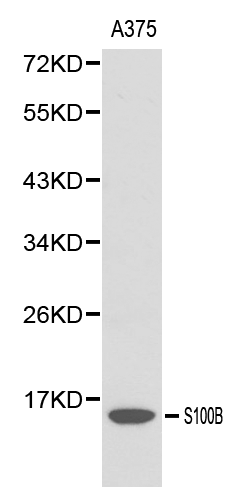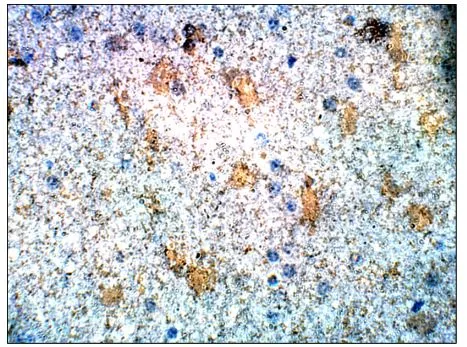![IHC-P analysis of human brain, cerebellun using GTX83327 S100 beta antibody [9A11B9]. IHC-P analysis of human brain, cerebellun using GTX83327 S100 beta antibody [9A11B9].](https://www.genetex.com/upload/website/prouct_img/normal/GTX83327/GTX83327_20170912_IHC-P_1_w_23061322_688.webp)
IHC-P analysis of human brain, cerebellun using GTX83327 S100 beta antibody [9A11B9].
S100 beta antibody [9A11B9]
GTX83327
ApplicationsWestern Blot, ELISA, ImmunoHistoChemistry, ImmunoHistoChemistry Paraffin
Product group Antibodies
TargetS100B
Overview
- SupplierGeneTex
- Product NameS100 beta antibody [9A11B9]
- Delivery Days Customer9
- Application Supplier NoteWB: 1/500 - 1/2000. IHC-P: 1/200 - 1/1000. ELISA: 1/10000. *Optimal dilutions/concentrations should be determined by the researcher.Not tested in other applications.
- ApplicationsWestern Blot, ELISA, ImmunoHistoChemistry, ImmunoHistoChemistry Paraffin
- CertificationResearch Use Only
- ClonalityMonoclonal
- Clone ID9A11B9
- ConjugateUnconjugated
- Gene ID6285
- Target nameS100B
- Target descriptionS100 calcium binding protein B
- Target synonymsNEF, S100, S100-B, S100beta, protein S100-B, S-100 calcium-binding protein, beta chain, S-100 protein subunit beta, S100 calcium-binding protein, beta (neural)
- HostMouse
- IsotypeIgG1
- Protein IDP04271
- Protein NameProtein S100-B
- Scientific DescriptionThe protein encoded by this gene is a member of the S100 family of proteins containing 2 EF-hand calcium-binding motifs. S100 proteins are localized in the cytoplasm and/or nucleus of a wide range of cells, and involved in the regulation of a number of cellular processes such as cell cycle progression and differentiation. S100 genes include at least 13 members which are located as a cluster on chromosome 1q21; however, this gene is located at 21q22.3. This protein may function in Neurite extension, proliferation of melanoma cells, stimulation of Ca2+ fluxes, inhibition of PKC-mediated phosphorylation, astrocytosis and axonal proliferation, and inhibition of microtubule assembly. Chromosomal rearrangements and altered expression of this gene have been implicated in several neurological, neoplastic, and other types of diseases, including Alzheimers disease, Downs syndrome, epilepsy, amyotrophic lateral sclerosis, melanoma, and type I diabetes. [provided by RefSeq, Jul 2008]
- Storage Instruction-20°C or -80°C,2°C to 8°C
- UNSPSC12352203

![IHC-P analysis of human brain (A) and human thymus tissue (B) using GTX83327 S100 beta antibody [9A11B9]. IHC-P analysis of human brain (A) and human thymus tissue (B) using GTX83327 S100 beta antibody [9A11B9].](https://www.genetex.com/upload/website/prouct_img/normal/GTX83327/GTX83327_20170912_IHC-P_w_23061322_385.webp)
![WB analysis of full-length S100B recombinant protein using GTX83327 S100 beta antibody [9A11B9]. WB analysis of full-length S100B recombinant protein using GTX83327 S100 beta antibody [9A11B9].](https://www.genetex.com/upload/website/prouct_img/normal/GTX83327/GTX83327_20170912_WB_w_23061322_321.webp)






